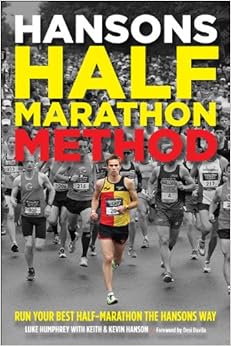This is the third in a series of summaries of the different aspects of
the Hanson's Half Marathon Method I'm using for my fall training. The first was on easy runs, and the second was on tempo runs.
For the most part, the Hanson's method treats speedwork like most other plans--repeats of varying distance at either 5K or 10K goal pace. The difference is in the amount of speedwork--it's a lot. The repeats of each of the distances--400 meters, 600, 800, 1K, and 1200--total 3 miles, but with recovery periods and warm-up and cool-down, the total will be more like 7.5 miles, and that's only doing the minimum amount of warm-up and cool-down. I've never done anywhere close to that much speedwork at once, especially not at 5 a.m. on a weekday morning like I'll be doing. The most I've ever run before work is 7 easy miles, and that was a single time. And while I considered skipping the warm-up and cool-down, the book says not to: "This remains one of the most important parts of training throughout the program because warming up and cooling down help to boost performance and speed up the recovery process following workouts."
The very first session--the one I'll be doing when this post publishes--is 12 X 400-meter repeats. Who does 12 X 400s?! Fast runners. Hard core runners. Not slow, non-confident me, surely. In fact, while this is probably the easiest of the speed sessions, it's the one that scares me most--12!!!!--and made me wonder if I really can do this plan. But, the workout is programmed into my Garmin, my outfit is laid out, and my water bottle is ready to go. I'm going to try my best!
You're all probably familiar with the benefits of speed workouts, but here's a primer from the book. Speed workouts improve the working muscles (specifically, the slow-twitch fibers and intermediate fibers), which thus improves running economy. There's an increased production of myoglobin, which help transport oxygen to the muscles and then to the mitochondria. Speed training can also increase anaerobic threshold. "Basically," the book says, "The speed intervals provide a two-for-one ticket by developing the anaerobic threshold and V02 max during the same workout. What's more, because speed sessions include high-intensity running near 100 percent V02 max (but not over), glyogen stores provide upwards of 90 percent of the energy, thus rapidly depleting them. This, in turn, forces the muscles to adapt and store more glyogen to be used later in workouts."
Correct pacing is essential to these workouts. "We cannot stress enough that workouts are designed to spur specific physiological adaptations; they are not to be run as hard as you can to see who is the last person standing."
The book gives the example of 6 X 800-meter repeats for a target time of 3:00 each repeat. "If you run the first three intervals at 2:45, 2:45, and 2:55, there's a good chance the last three will be around 3:10, 3:15, and perhaps 3:10. While you averaged 3:00, you failed to hit a single interval at the prescribed pace. This means that you didn't accumulate any training at the desired pace, which was specifically set to stimulate aerobic capacity. The first three were too fast, which exceeded V02 max, producing anaerobic energy and lactic acid. The last three were then progressively slower due to fatigue and lactic acid buildup. In the end, you drove yourself into the ground without gaining any major physiological benefits."
I don't do well with hitting exact paces, so this will be a huge struggle for me.
In addition to the physiological benefits, speed training
teaches your mind to handle hard work. I need practice with hard
workouts and being uncomfortable, so while the speed work will be a huge
challenge, it's medicine I need to take to become a better runner. As the book says, "Every speed workout you complete is like money in the back when it comes to resources on which you can draw during the most difficult moments of the race."
When considering a training plan for the fall, I knew I wanted one that would take me out of my comfort zone. The following from the book convinced me to try this plan:
Speed workouts help a runner develop supreme mental toughness. Thee sessions force you to run at a higher intensity for a longer time, drawing you out of your comfort zone and into new territory. Remember, the only way to improve fitness is by bumping it up from the bottom; each time you step slightly out of your comfort zone, your body responds to the new stimulus. When you learn to tolerate discomfort for longer and longer durations, the payoff is multifold: You gain speed, discover your true potential, and become comfortable with higher-intensity training. What's more, you also develop a higher anaerobic threshold and aerobic capacity without ever training beyond V02 max and risking injury.
Let the speedwork begin!
Do you love or hate speedwork? What's your favorite speed workout? What's the most number of repeats you've ever done? Labels: Hansons Half Marathon Method
